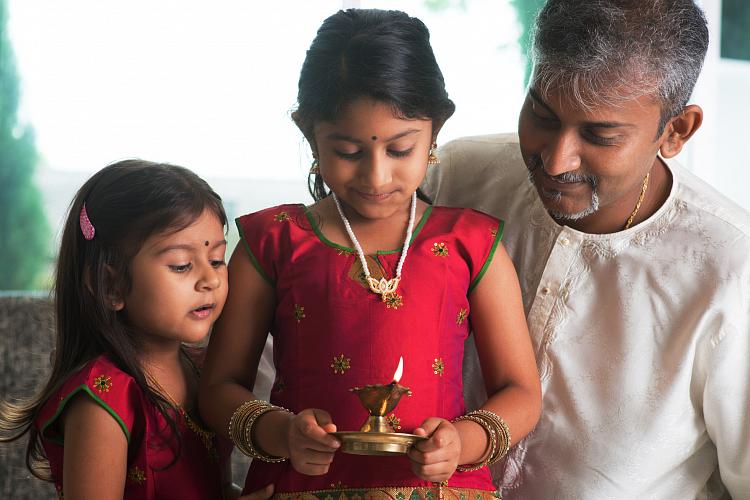
Best Comet of 2025?
C/2024 G3 (ATLAS) has already become very faintly visible to the naked eye for observers in the Southern Hemisphere.
Hindu holidays and festivals celebrate themes like Hindu gods and goddesses, renewal and beginning, relationships, and historical events. They vary greatly by region and community.

Diwali is one of the biggest festivals within Hinduism.
©iStockphoto.com/szefei
Hinduism, one of the world’s oldest religions, has a rich tapestry of festivals and holidays that are celebrated throughout the year. These festivals often have religious, cultural, and seasonal significance. Here are some of the major Hindu holidays and festivals:
These are just a few examples of Hindu festivals, and there are many more celebrated across India and among Hindu communities around the world. The dates of these festivals are based on the Hindu lunar calendar, so they vary from year to year in the Gregorian calendar.
The Hindu calendar is both intricate and diverse—there is no single universally accepted Hindu calendar. This often results in different dates within the Gregorian calendar for the same holiday among different denominations of Hindus.
At timeanddate.com, we follow official government calendars to report the dates of public holidays in a country.
Different regions and Hindu sects within the Indian subcontinent and beyond follow different calendrical traditions.
For example, Nepal uses the Vikram Samvat as its official calendar. In contrast, the Indian government officially uses the Shaka or Saka calendar to set the dates for Indian public holidays.
Hindus in Bangladesh and the Indian state of West Bengal follow the Bengali Hindu Calendar. At the same time, Tamilian Hindus around the world, including in Sri Lanka, Mauritius, Singapore, and India, use the Tamil Calendar, while Hindus from the Indian state of Kerala use the Malayalam Calendar.
Modern Hindu calendars are all loosely based on the Surya Siddhantha, an ancient astronomy text in Sanskrit, and tend to follow both the Sun and the Moon to determine the rules for the first day of the year, the start or end of the month (sankranti), and when a day begins. Some calendars also rely on the stars and constellations to decide on the dates for important religious holidays.
In some of these calendars, the first day of the year falls on different days. Some communities, like the Hindus in Kerala, celebrate two new years—a solar new year, on the first day of Chingam, and the astronomical new year, Vishu, which falls on the first day of the month of Metam.
| Calendar | Name of the Holiday | Month in Hindu Calendar | Date in Gregorian Calendar | ||||||||
|---|---|---|---|---|---|---|---|---|---|---|---|
| Bengali Calendar | Pahela Baisakh | Baisakh 1 | Around April 14 | ||||||||
| Malyali Calendar | Chingam Onnu (Solar New Year) | Chingam 1 | Around April 14 | ||||||||
| Malyali Calendar | Vishu (Astronomical New Year) | Medam 1 | Around August 15 | ||||||||
| Orissa Calendar | Pana Sankranti / Maha Vishuba Sankranti | Mesha 1 | Around April 14 | ||||||||
| Tamil Calendar | Puthandu | Chithirai 1 | Around April 14 | ||||||||
| Nepal Calendar | Nava Varsha | Baisakh 1 | Around April 14 | ||||||||
A month in most Hindu calendars begins when the Sun moves from one constellation into another. This moment marks Sankranti.
There are two measures of a day within the Hindu tradition: Divas or the solar day and tithi, which is based on the movement of the Moon with respect to the Sun. Astronomically, it is the time it takes for the Moon to increase its angular distance from the Sun by 12 degrees.
A Divas spans from sunrise to sunrise and forms the basis of the civil day within the Hindu tradition. On the other hand, a tithi, which is a lunar date, can start any time of the day and can span multiple divas. Two tithis can also occur during a single divas.
Sunrise and Sunset times for your location
The tithi at sunrise is considered the tithi of the day.
Most Hindu holidays fall on a specific tithi. For example, the date of Diwali, the Hindu festival of lights, is calculated by determining when the amavasya (New Moon) tithi falls after sunset in the month of Kartik.
Since the dates of the New Moon change each year, the date of the amavasya tithi also varies from one year to the next in the Gregorian calendar, usually falling in the months of October or November.
Because tithis are based on the apparent distance between the Moon and the Sun in the sky, they begin and end at the same time around the world. But because the tithi of the day depends on when sunrise takes place, it can differ from one location to another. This is why many Hindu festivals tend to fall on different dates around the world.
Different Indian calendars can also define the tithi of a holiday differently. For instance, in the Tamil calendar, Diwali takes place on the day when the chaturdashi tithi falls right before sunrise. This means that Diwali in the Tamil calendar often falls a day before Diwali in many other Hindu calendars. Only when chaturdarshi falls before sunrise and amavasya falls after sunset on the same day, do the two dates of Diwali coincide.

C/2024 G3 (ATLAS) has already become very faintly visible to the naked eye for observers in the Southern Hemisphere.

How does the 12-hour clock system work? Is midnight 12 am or 12 pm?

Why do many countries set the clocks back and forth an hour twice a year?

Why are there 12 months? How long are they, and what do the month names mean?